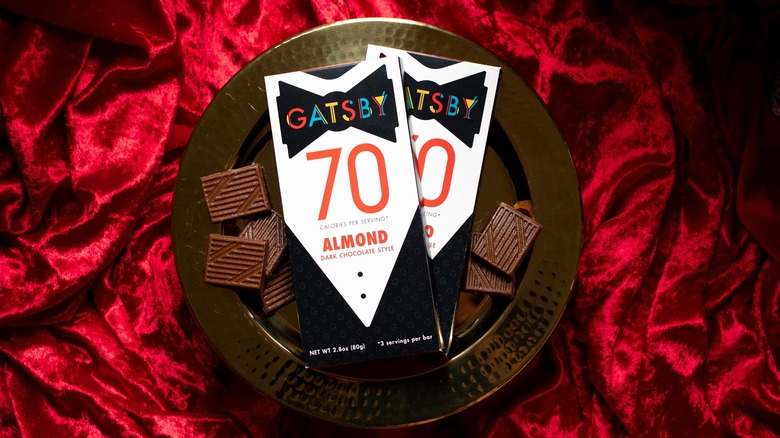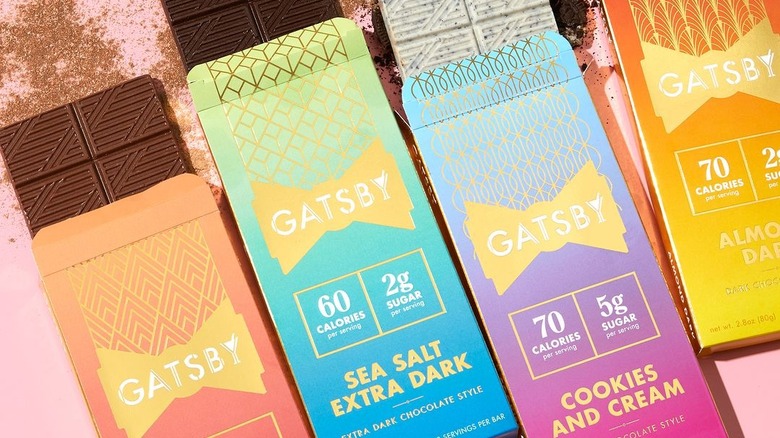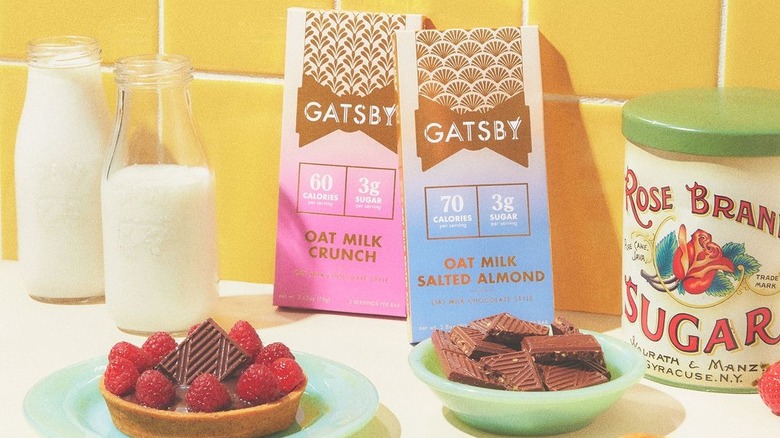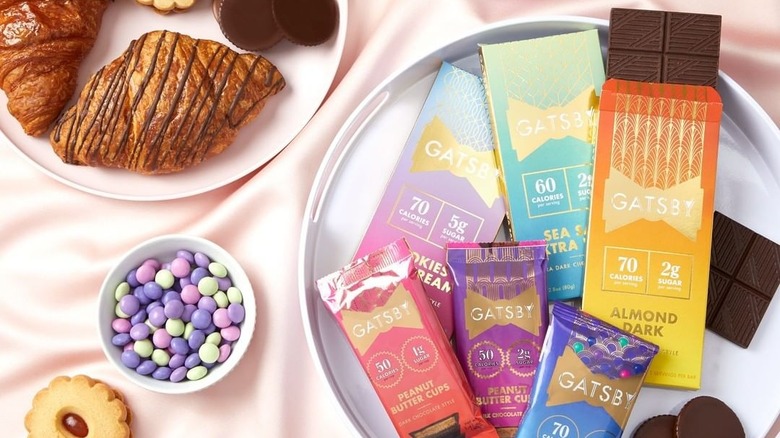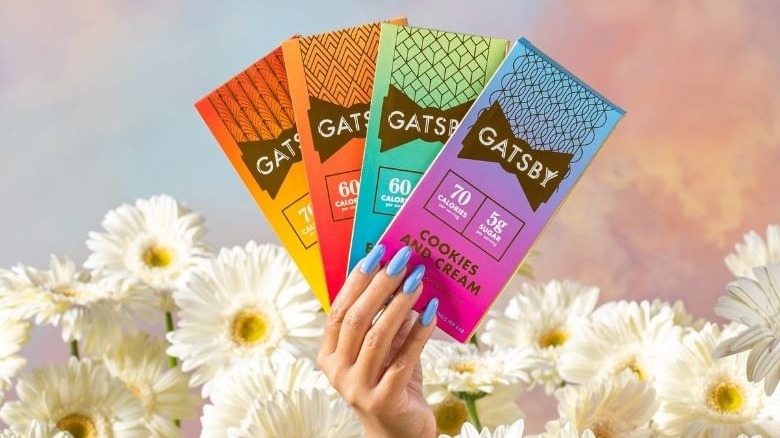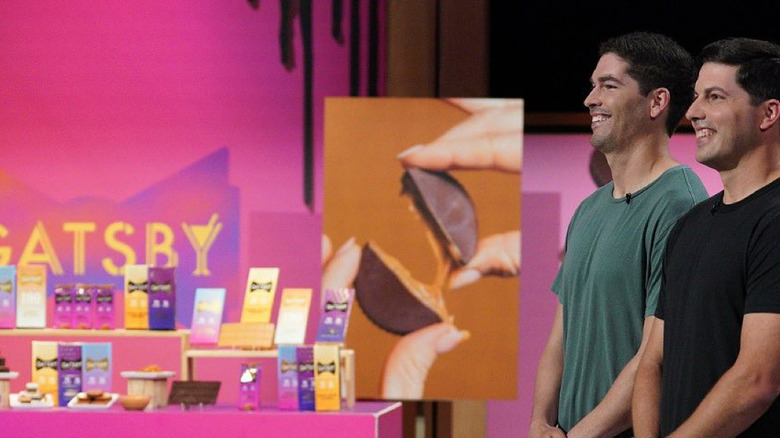Details You'll Want To Know About Shark Tank's Gatsby Chocolate
As "Shark Tank" Season 15 deals flood our screens, it's time for Friday nights to be filled with heated discussions and tough negotiations once again. While the Sharks put hopeful entrepreneurs on the hot seat to gauge whether their companies are investable, fans are introduced to new businesses from across the country; from nifty cleaning solutions and fugly sweaters to products that change the way people sleep and do their business in the loo, there have been many life-changing businesses on "Shark Tank" in the past. Safe to say, Season 15 is going to be no different.
Among the three businesses featured on the season premiere is Gatsby Chocolate, a company that makes low-calorie and low-sugar chocolates that still pack the decadent melt-in-your-mouth texture that is expected of premium confections. With flavors like cookies and cream, fudge brownie, and almond dark chocolate, Gatsby claims to have nearly half the calories and 75% less sugar than some chocolates on the market, all while also offering vegan, gluten-free, and dairy-free options.
Although much was said about Gatsby Chocolate on "Shark Tank," there's also a lot that fans still don't know about the business that is inspired by Scott Fitzgerald's novel. From the illustrious entrepreneurial history of Gatsby's founder (yes, you already know his other brand) to what its chocolates are actually made from, here's what you should know about Gatsby Chocolate.
Gatsby Chocolate's founder was also the co-founder of Halo Top
Gatsby Chocolate was introduced to the Sharks by Doug Bouton, founder and CEO, but this isn't Bouton's first go at running a successful company, nor is it his first time offering low-calorie versions of delicious desserts. The entrepreneur was also the co-founder of Halo Top, a low-calorie ice cream company that increased its sales from $2 million in 2015 to $350 million in 2017 — beating the likes of Ben & Jerry's and Häagen-Dazs to become the bestselling ice cream pint in America (per Forbes).
Bouton launched Halo Top in 2012 with Justin Woolverton whom he met at a basketball league for lawyers. The lawyer-turned-entrepreneurs quickly joined hands, divided responsibilities, and launched Halo Top, which at the time was one of the first ice cream companies of its kind. Despite soaring sales, beating industry leaders, and making it to lists like Time Magazine's "25 Best Inventions of 2017," the entrepreneurs faced many challenges; Halo Top had grown too quickly and competition was entering the market.
Amidst declining sales in 2018 and 2019, Bouton and Woolverton sold Halo Top to Iowa-based Blue Ribbon Classics owner Wells Enterprises. Although Bouton is still the CEO of Halo Top, he began to look toward applying the low-calorie philosophy to another sweet treat after the sale, and with ice cream out of the picture due to a non-compete clause, he focused his attention on another popular category: chocolate.
It took a year to develop the recipe for Gatsby Chocolate
Bouton decided to enter the chocolate business for several reasons, including a gap in the market for low-calorie chocolates. He noticed that there were no low-calorie chocolates on offer and even low-sugar alternatives ranked pretty high in the calorie department. Taking the example of Lily's — famous for its stevia-sweetened chocolates — Bouton told Forbes that despite being low in sugar, their chocolates had just as many calories as the likes of Hershey's.
Between the sale of Halo Top to Wells Enterprises and Gatsby Chocolate's arrival in grocery stores in 2022, Bouton spent quite a year working on his recipe. The entrepreneur began to find ways to trim down the calories by reducing sugar and fat whilst adding protein and fiber, also giving his Gatsby the same flavor and smooth texture as premium chocolates.
Bouton didn't stop at just a low-calorie and low-sugar nutrition-driven formulation though; he also wanted to play with flavors and the form in which they could be packed. Gatsby soon launched milk chocolate gems — which it claimed had three times fewer calories than M&Ms — as well as peanut butter cups in dark, milk, and white chocolate varieties. And when that got old, it turned peanut butter into a bar of chocolate. Soon Gatsby entered the dairy-free and vegan market as well, offering low-calorie and low-sugar bars of chocolates made from oat milk.
Gatsby Chocolate already has stellar reviews
It's not very often that viewers get to see businesses on "Shark Tank" that have already made a name for themselves in the market, but Gatsby Chocolate has. A two-time entrepreneur with tons of experience in the nutrition-focused dessert industry, Bouton's expertise may have played an important role in Gatsby's quick rise in the world of chocolate. Besides being available in Walmart stores nationwide, Gatsby's chocolates also have a trunk of glowing reviews.
Gatsby's almond dark chocolate variant has the approval of U.S. News dietician Julie Upton – and its peanut butter cups made their way onto PureWow's list of summer essentials in 2022. Gatsby also came out 25th on PureWow's ranking of gourmet chocolates — which included the likes of Lily's and Lindt — getting an overall mark of 83 out of 100 based on flavor, texture, quality, value, and aesthetics. The review went on to add that despite a certain lack of richness and a powdery texture to its almond dark chocolate bar, it had a balanced sweetness to it and tasted like traditional chocolate except with fewer calories and less sugar.
With a 4.6 out of 5 rating based on 185 reviews for its sea salt dark chocolate, the consensus on Walmart's website also is in Gatsby's favor. Shoppers have called it the "best sea salt and extra dark chocolate bar... (with) a perfect blend of sweet and salty," with one reviewer adding, "I'd give it more than 5 stars if I could."
Gatsby's chocolates are made from MCT oil, allulose, and EPG
Considering the fact that there were no other low-calorie options quite like Gatsby Chocolate when it began, the question that arises is what exactly are the chocolates made from? Gatsby's chocolates have cocoa powder and add-ins depending on the flavor of the chocolate of course, but they get their low-calorie, low-sugar, and melt-in-your-mouth qualities from other ingredients.
Gatsby uses allulose, EPG (esterified propoxylated glycerol), and MCT (medium-chain triglycerides) oil across its chocolates. EPG is a fat replacement ingredient derived from canola that Epogee — the company that Gatsby Chocolate sources its EPG from — claims can cut 92% of the calories that come from fat without compromising on flavor and texture, which may be why Gatsby's confections retain a decadent texture despite slashing the calories (via Epogee). MCT oils such as palm kernel oil, on the other hand, have 10% fewer calories than LCTs like olive oil, which is why it is a popular swap.
The third ingredient that Gatsby Chocolate uses is allulose or D-psicose, a sugar substitute that has 70% of the sweetness of sugar but with fewer calories. Although more research is needed on this relatively new sugar substitute, not everyone has positive things to say about the ingredients that Gatsby Chocolate uses. Calling them "creatures of a food-scientist's lab" that are "highly processed chocolate-like substances" at best, one Redditor pointed out that Gatsby's low-calorie chocolates come at the cost of highly processed components.
Gatsby Chocolate calls its biggest demographic Power Women
When Halo Top launched in 2012 and quickly became an internet sensation, a large part of the company's success was credited to its marketing, which packaged the ice creams as uber-cool, trendy, and more nutritious alternatives for young ice cream-loving Americans. With Gatsby Chocolate, Bouton calls the company's demographic audience "Power Women."
In an interview with GoSolo, Bouton explains that "Power Women" are "boss ladies" who are in their late 20s and early or mid-30s. The demographic includes single women at the beginning of their careers who balance work and social lives; young moms navigating between kids, careers, families, and other responsibilities; and generally all women in this age bracket. In another interview with The Chicago North Shore Moms Network, Bouton presumed that young mothers on the go like to eat chocolate after lunch and dinner or as a quick afternoon pick-me-up. Bouton hopes that Gatsby Chocolate "can give these superhero 'Power Women' something that makes their life a bit easier and happier" and "the melt-in-your-mouth taste they deserve," one chocolate at a time. Take of that what you will.
What happened to Gatsby Chocolate on Shark Tank
Brothers-turned-business partners Doug and Ryan Bouton walked into "Shark Tank" calling Gatsby the Halo Top of chocolate, but it wasn't just Halo Top's past success that intrigued the Sharks: It was also the taste of Gatsby's chocolates. Daymond John gave Gatsby a thumbs up as did Lori Greiner who was impressed by the fudge brownie chocolate's flavour and the low 190 calories that the big bar packed. But with a $500,000 ask for 5% of equity, the Sharks needed more convincing.
Despite $2.5 million in sales from over 6,000 distributors the previous year, the Bouton brothers admitted that they had actually lost $3.5 million. Although the Sharks largely didn't see big issues with Gatsby's sales or its valuation, not everyone was keen on the low-calorie chocolate business. John confessed that he didn't see what value he could add to Gatsby, adding that it was he who would be calling the Halo Top co-founder for advice. Guest shark Candice Nelson also backed out due to concerns over their packaging and the overemphasis on calorie content.
Kevin O'Leary proposed the $500,000 investment as venture debt, but it was ultimately a joint deal with Greiner and Mark Cuban that the entrepreneurs chose. The Bouton brothers walked off with a $250,000 investment in exchange for 20% equity and another $250,000 in loan. The entrepreneurs also agreed to Greiner and Cuban's equity rising to 30% when Gatsby's sales hit $10 million, and further upping their equity to 40% at $50 million sales.

